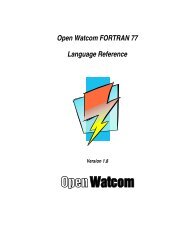Relocatable Object Module Format (OMF) Specification
Relocatable Object Module Format (OMF) Specification
Relocatable Object Module Format (OMF) Specification
Create successful ePaper yourself
Turn your PDF publications into a flip-book with our unique Google optimized e-Paper software.
<strong>Relocatable</strong> <strong>Object</strong> <strong>Module</strong> <strong>Format</strong><br />
A0H or A1H LEDATA—Logical Enumerated Data Record<br />
Description<br />
This record provides contiguous binary data—executable code or program data—that is part of a program<br />
segment. The data is eventually copied into the program's executable binary image by the linker.<br />
The data bytes may be subject to relocation or fixing up as determined by the presence of a subsequent FIXUPP<br />
record, but otherwise they require no expansion when mapped to memory at run time.<br />
History<br />
Record type A1H was added for 32-bit linkers; it has an Enumerated Data Offset field of 32 bits rather than 16 bits.<br />
Record <strong>Format</strong><br />
1 2 1 or 2 2 or 4 1<br />
A0 Record Segment Enumerated Data Checksum<br />
or A1 Length Index Data Offset Bytes<br />
Segment Index Field<br />
The Segment Index field must be nonzero and is the index of a previously defined SEGDEF record. This is the<br />
segment into which the data in this LEDATA record is to be placed.<br />
Enumerated Data Offset Field<br />
The Enumerated Data Offset field is either a 2- or 4-byte field (depending on the record type) that determines the<br />
offset at which the first data byte is to be placed relative to the start of the SEGDEF segment. Successive data<br />
bytes occupy successively higher locations.<br />
Data Bytes Field<br />
The maximum number of data bytes is 1024, so that a FIXUPP Location field, which is 10 bits, can reference any<br />
of these data bytes.<br />
Notes<br />
Record type A1H has the offset stored as a 32-bit value. Record type A0H encodes the offset value as<br />
a 16-bit numeric field (zero-extended if applied to a Use32 segment).<br />
If an LEDATA record requires a fixup, a FIXUPP record must immediately follow the LEDATA record.<br />
Code for functions is output in LEDATA records currently. The segment for code is usually named<br />
_TEXT (or module_TEXT, depending on the memory model), unless #pragma alloc_text is used to<br />
specify a different code segment for the specified functions.<br />
For instantiated functions in Microsoft C++, code will simply be output in COMDAT records that refer to<br />
the function and identify the function's segment.<br />
Data, usually generated by initialized variables (global or static), is output in LEDATA/LIDATA records<br />
referring to either a data segment or, possibly, a segment created for a based variable.<br />
Tool Interface Standards (TIS) <strong>OMF</strong> <strong>Specification</strong>, Version 1.1 47
















